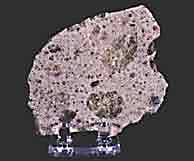Top Qs
Timeline
Chat
Perspective
Diogenite
Group of achondritic stony meteorites that originate from the asteroid 4 Vesta From Wikipedia, the free encyclopedia
Remove ads
Diogenites are a group of the HED meteorite clan, a type of achondritic stony meteorites.
Remove ads
Origin and composition
Diogenites are currently believed to originate from deep within the crust of the asteroid 4 Vesta, and as such are part of the HED meteorite clan. There are about 40 distinct members known.
Diogenites are composed of igneous rocks of plutonic origin, having solidified slowly enough deep within Vesta's crust to form crystals which are larger than in the eucrites. These crystals are primarily magnesium-rich orthopyroxene, with small amounts of plagioclase and olivine.[1]
Remove ads
Name
Diogenites are named for Diogenes of Apollonia, an ancient Greek philosopher who was the first to suggest an outer space origin for meteorites.[2]
See also
References
External links
Wikiwand - on
Seamless Wikipedia browsing. On steroids.
Remove ads


